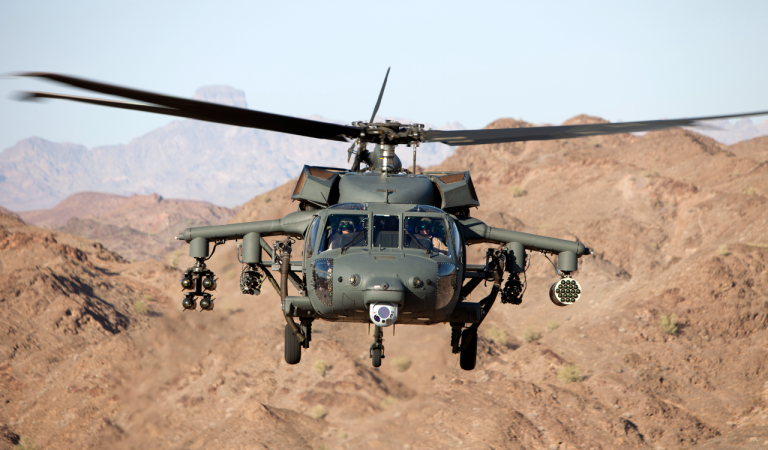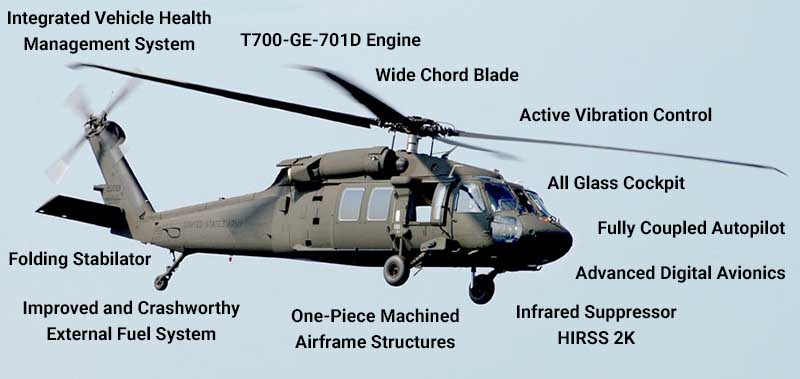Why the UH 60 Remains a Fave Selection Amongst Armed Forces Worldwide
Why the UH 60 Remains a Fave Selection Amongst Armed Forces Worldwide
Blog Article
UH-60: Advancements in Modern Helicopter Style
The UH-60 helicopter stands as a benchmark in modern-day aeronautics, showcasing considerable advancements in style and technology that cater to the advancing demands of armed forces procedures. As we discover the advancement and essential advancements of the UH-60, it comes to be vital to take into consideration just how these developments influence not only existing applications yet also the future landscape of helicopter style.

Advancement of the UH-60
The development of the UH-60 Black Hawk helicopter represents a substantial landmark in aerospace engineering and army aeronautics. Introduced in the late 1970s, the UH-60 was developed by Sikorsky Airplane to satisfy the United States Military's requirement for a versatile energy helicopter capable of executing a range of missions. Its style highlighted rate, maneuverability, and longevity, establishing new standards for functional efficiency.
The UH-60 features an unique four-blade rotor system, which enhances lift and stability, allowing it to operate effectively in diverse settings. Its airframe is created from innovative composite products, contributing to a decrease in weight while keeping architectural integrity. The helicopter's style also incorporates improved aerodynamics, which boosts fuel effectiveness and enhances variety.
Throughout the years, the Black Hawk has undergone numerous upgrades to boost its capabilities, consisting of boosted engines, advanced trip control systems, and modular systems for easy upkeep and versatility. The helicopter's ability to execute objectives ranging from troop transportation to medical discharge has strengthened its duty as a foundation of united state military procedures. The UH-60 Black Hawk stays an archetype of just how development in helicopter layout can substantially impact army efficiency and functional flexibility.
Advanced Avionics Systems
Developments in avionics systems have changed the abilities of modern helicopters like the UH-60 Black Hawk, boosting functional efficiency and situational understanding (UH 60). The combination of innovative avionics permits enhanced navigation, communication, and flight monitoring, making the UH-60 extra versatile in varied goal accounts
Among the crucial features is the innovative electronic cockpit, which employs multifunction screens that offer real-time data, ensuring pilots have instant access to vital flight information. This streamlining of info decreases pilot workload and enhances decision-making processes throughout complex procedures. Additionally, the incorporation of general practitioner and inertial navigation systems makes it possible for accurate positioning and route planning, boosting goal execution in difficult settings.
Additionally, progressed avionics systems improve communication abilities via safe and secure data web links and voice interaction systems, permitting seamless control with ground forces and various other airplane. The assimilation of automatic flight control systems further contributes to enhanced security and control, especially in damaging weather or throughout low-altitude maneuvers.
Engine and Efficiency Enhancements
Engine performance in modern helicopters has taken a significant leap ahead, driven by advancements that improve power, reliability, and efficiency. At the center of these developments is the fostering of more powerful turboshaft engines, particularly those using innovative materials and technologies that enable greater temperature level tolerances and boosted drive abilities. The UH-60 Black Hawk, for circumstances, uses the T700-GE-701C engine, which includes a dual-channel, full-authority electronic engine control system. This system enhances efficiency while maximizing fuel usage and decreasing upkeep needs.
Furthermore, the assimilation of engine health surveillance systems permits real-time diagnostics and predictive maintenance, significantly enhancing operational reliability. These systems not only sharp staffs to prospective issues before they come to be vital yet additionally help with more efficient upkeep scheduling, therefore decreasing downtime.

Materials and Structural Innovations
Current growths in products and structural style have actually revolutionized modern helicopter construction, enhancing both efficiency and resilience. The introduction of sophisticated composite materials, such as carbon fiber enhanced polymers, has actually substantially minimized weight while keeping architectural integrity. This shift not only enhances gas efficiency but additionally enhances payload capability, permitting helicopters like the UH-60 to perform more varied objectives.
In addition, developments in aluminum alloys and titanium components have actually added to enhanced resistance to deterioration and exhaustion, prolonging the lifespan of important airframe elements. The strategic use these materials has actually brought about a reduction in upkeep needs and enhanced total operational preparedness.

Additionally, the integration of computer-aided design (CAD) and additive manufacturing technologies has actually allowed much more complicated geometries and lightweight structures, enhancing the aerodynamic performance of helicopter styles. These innovations assist in quick prototyping and manufacturing, enabling makers to respond quickly to evolving goal requirements.
Safety and Survivability Functions
Security and survivability features in modern helicopter design have come to be paramount, mirroring the increasing needs for mission effectiveness in tough atmospheres. The UH-60 Black Hawk, a remarkable example, integrates innovative innovations to boost staff and traveler protection.
The helicopter additionally utilizes a ballistic protection system, which consists of armored staff seats and crucial systems shielding, lowering susceptability to small arms fire and shrapnel. Enhanced situational understanding is accomplished through advanced avionics and sensor technologies, allowing pilots to detect and prevent threats properly.
Additionally, the integration of redundancy in essential systems-- such as double engines and several trip control networks-- guarantees ongoing procedure also if one system fails. The UH-60 is geared up with sophisticated emergency situation flotation protection devices, boosting survivability in water touchdowns. Collectively, these features not just enhance the security of workers yet also enhance goal success prices in aggressive environments, demonstrating the commitment to excellence in helicopter design.
Verdict
The UH-60 helicopter stands for a significant improvement in contemporary aeronautics innovation, incorporating innovative products, innovative avionics, and durable safety and security features. Generally, the UH-60 serves as a standard for future developments in helicopter design, symbolizing resilience and flexibility in modern military procedures.
The UH-60 helicopter stands check out here as a criteria in contemporary air travel, showcasing substantial advancements in layout and modern technology that cater to the evolving needs of army operations. As we explore the advancement and crucial advancements of the UH-60, it comes to be necessary to take into consideration just how these advancements affect not just existing applications however also check my reference the future landscape of helicopter design.
Introduced in the late 1970s, the UH-60 was developed by Sikorsky Airplane to fulfill the United States Military's requirement for a functional utility helicopter qualified of carrying out a selection of goals. The UH-60 Black Hawk continues to be a prime example of how innovation in helicopter style can dramatically influence military performance and functional adaptability.
Generally, the UH-60 serves as a standard for future developments in helicopter style, embodying durability and adaptability in modern armed forces procedures.
Report this page